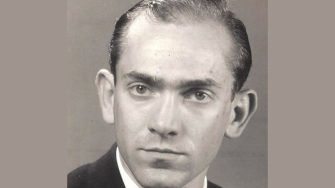
It is with sadness that we acknowledge the passing of Professor Thomas Torda, a long-standing member of the Faculty of Medicine & Health. Professor Torda was the father of Professor Adrienne Torda, Head of School and Vice Dean, School of Clinical Medicine at UNSW.
The following was written by Dr Matthew Crawford and provides some insight into Tom’s remarkable life and the significant contributions he made to society.
Tom was born in Budapest on 9/11/1932, the son of a faciomaxillary surgeon. At nine years of age, he and his family were forced into a concentration camp in Germany. They were not executed, as they were regarded as a high value asset that could “traded” to Switzerland.
In Switzerland, his father soon became the refugee camp doctor, causing the family being relocated frequently. Tom lived in four different countries over a period of three years and became multilingual. In 1948 the family emigrated to Australia and finally settled in Sydney. Tom attended Sydney Grammar School, obtaining a Commonwealth Scholarship, allowing him attend Sydney University to study Medicine. Whilst still a medical student, he joined the Citizens Air Force, progressed to the rank of flight lieutenant, and learnt to fly. He graduated in 1958 and spent his internship at Sydney Hospital and then took up an anaesthesia training position at Royal Perth Hospital.
In 1960 Tom decided to undertake further studies at St Georges Hospital in London. He obtained a Diploma in Anaesthetics in 1961 and a Fellowship of Anaesthetics in 1962. During his time there he met and married Phyllis Howard, an operating theatre nurse and had their first child, Andrew. The family then moved to New York where he undertook a Fellowship in Anesthesiology at the Montefiori Hospital in 1963. Subsequently he took up a position at the Albert Einstein College of Medicine in 1964, where their second child, Adrienne, was born.
The family moved back to Australia in 1966 and Tom was appointed as a Staff Specialist in Anaesthesia and Intensive Care at Prince Henry Hospital. He developed one of the first Intensive Care Units in Australia, treating patients with respiratory failure due to poliomyelitis. Over the years, these patients would return for ongoing medical care, and there was always a bed available for them. He knew them all, and they became part of his extended family.
Tom was also a physical fitness fanatic, into running and scuba diving. When computers appeared on the scene, he became a computer afficionado, learning all the various programming languages that were being developed. In 1979, he became the Academic Head and Chairman of the Department of Anaesthesia and Intensive Care at Prince Henry, Prince of Wales, and the Sydney Children’s Hospital. He was a member of the NSW Regional Committee of the Faculty of Anaesthetics, RACS. As a member of Anaesthesia Continuing Education Committee, he was the organiser and convenor of the first anaesthetic CME meeting in Australia. He was involved with the NSW Department of Health in developing the occupational health and safety guidelines for acceptable levels of anaesthetic gas pollution in operating theatres. This earned him many visiting professorships in Europe, USA, Middle East, Southeast Asia and Australia.
Tom strove for excellence in everything he was involved with. He was passionate about his research, publishing almost 100 scientific papers and writing more than 13 book chapters. He was always willing to share his wisdom with those who sought his guidance. As such he was a great leader, being very loyal and supportive. Through all of this he was able to give time to his family, patients, colleagues, and trainees. In 2000, Tom was awarded the Medal of the Order of Australia (OAM) for his influence upon the advancement of Anaesthesia in Australasia. Even after he ceased clinical work he continued teaching and his research at UNSW for many years.
Once he did retire, he and Phyllis undertook many trips overseas where he pursued his love of photography. He was a doting grandfather. He and Phyllis moved house to be closer to their family. They regularly undertook child minding duties, attended soccer games and athletics carnivals. There was absolutely nothing the two wouldn't do for their grandchildren. In 2016, Tom had a major stroke and was left with severe dysphasia and dyspraxia which made it necessary for him to move to a nursing home. The staff absolutely loved him there. He was very content and stable there until just a few weeks prior to his death. He decided it was his time to go and he passed away quickly and peacefully.
Tom taught us more than anaesthesia and critical care. He taught us how to manage patients and families under severe distress, with calmness and dignity. He taught us humility, compassion, and respect. We will be forever grateful for the time he gave us.
